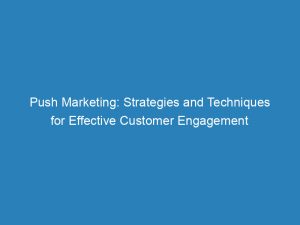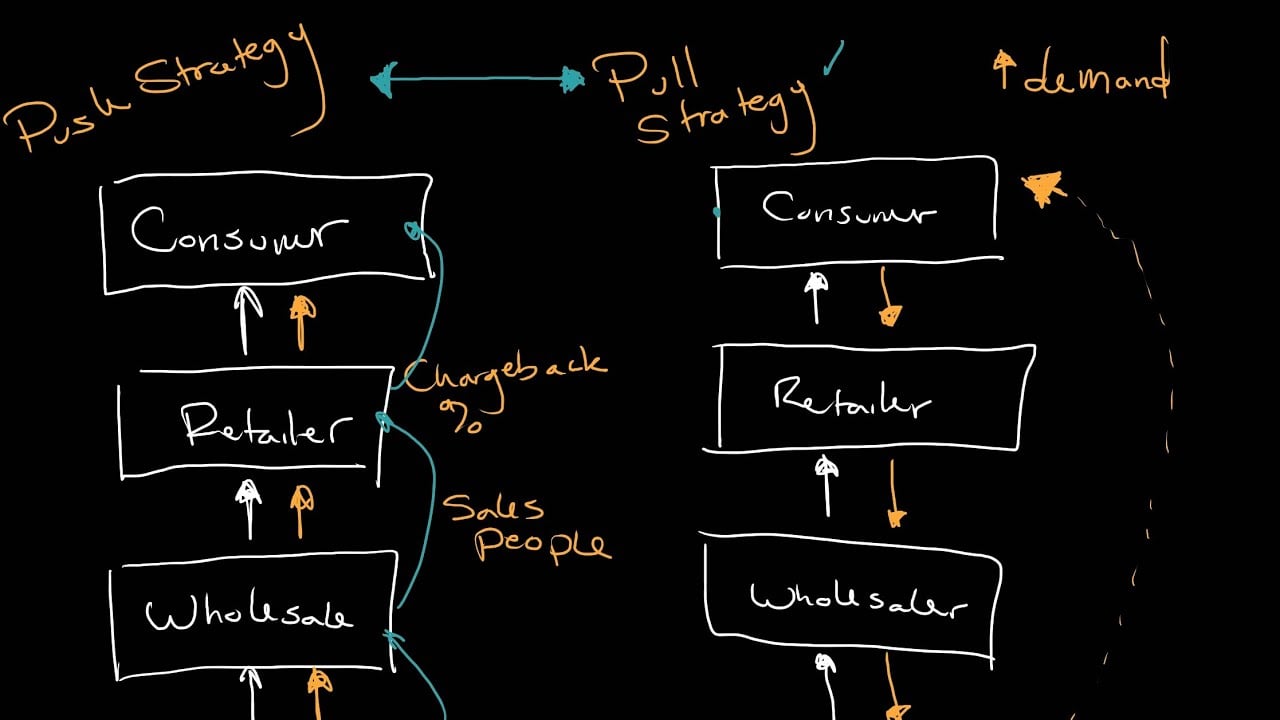In the fast-paced world of advertising and marketing, there are two strategies that battle for attention and consumer loyalty: push marketing and pullmarketing. It’s a clash between immediate results and long-term growth, between a hard sell and a gentle persuader.
Today, we delve into the realm of push marketing, a strategy aimed at catching consumers’ attention, sparking their desire, and ultimately pushing them towards making a purchase. With its arsenal of paid advertisements and attention-grabbing sales promotions, pushmarketing plays a crucial role in bringing products to the forefront of consumers’ minds.
So buckle up and prepare to discover the power of push marketing in today’s competitive business landscape.
Table of Contents
push marketing
Push marketing is a promotional strategy that involves directly advertising and promoting products to customers. This approach is aimed at generating immediate sales by reaching out to customers and persuading them to buy.
Examples of push marketing tactics include paid advertising, sales promotions, email marketing, and telemarketing. Unlike pull marketing, which focuses on attracting and engaging customers through valuable content, push marketing is more focused on bringing products to customers’ attention.
While push marketing can be effective for introducing new products and generating immediate sales, combining push and pull marketing strategies can be even more successful in reaching the target audience and driving sales.Key Points:
- Push marketing directly advertises and promotes products to customers to generate immediate sales.
- Examples of push marketing tactics include paid advertising, sales promotions, email marketing, and telemarketing.
- Push marketing focuses on bringing products to the customers’ attention rather than engaging them with valuable content.
- Combining push and pull marketing strategies can be more successful in reaching the target audience and driving sales.
- Push marketing is effective for introducing new products and generating immediate sales.
- Pull marketing focuses on attracting and engaging customers through valuable content.
Sources
https://blog.hubspot.com/marketing/push-vs-pull-marketing
https://corporatefinanceinstitute.com/resources/management/push-marketing-strategy/
https://ahrefs.com/blog/push-vs-pull-marketing/
https://insights.digitalmediasolutions.com/articles-3/push-marketing-intro-part-1
Check this out:
💡 Pro Tips:
1. Utilize social media advertising: In addition to traditional paid advertising, consider using social media platforms like Facebook, Instagram, and Twitter to reach and engage with your target audience. These platforms offer targeted advertising options that can help you reach the right customers.
2. Personalize your email marketing campaigns: Instead of sending generic email blasts to your entire database, segment your audience and create personalized email campaigns that speak directly to their interests and preferences. This will help increase open rates and engagement with your emails.
3. Offer exclusive discounts or promotions: To incentivize immediate purchases, consider offering exclusive discounts or promotions to customers who make a purchase within a certain time frame. This can create a sense of urgency and drive customers to take action.
4. Leverage influencer marketing: Identify influencers or industry experts who resonate with your target audience and partner with them to promote your products or services. Their endorsement can help build trust and credibility with your potential customers.
5. Implement referral programs: Encourage your satisfied customers to refer their friends and family members to your business by offering referral incentives. This can help generate word-of-mouth marketing and attract new customers who are more likely to make a purchase based on a recommendation from someone they trust.
Introduction To Push Marketing
Push marketing is a strategy that involves directly promoting and pushing products to customers. This form of marketing aims to generate immediate sales by reaching out to customers and persuading them to buy.
Unlike pull marketing, which focuses on attracting and engaging customers through valuable content, push marketing takes a more proactive approach in bringing products to customers’ attention.
Push marketing is particularly effective for introducing new products to the market and creating a buzz around them. By aggressively promoting and pushing products through various channels, marketers can generate awareness and interest among potential customers.
It allows companies to reach a wide audience quickly and deliver persuasive messages that encourage immediate action.
Examples Of Push Marketing
There are various examples of push marketing strategies that companies utilize to promote their products effectively. Some of these strategies include:
Paid advertising: This includes traditional advertising channels such as television, radio, newspapers, and magazines, as well as digital platforms like display ads and sponsored social media posts.
Sales promotions: Offering discounts, limited-time offers, or freebies to customers to incentivize them to make a purchase.
Email marketing: Sending promotional emails to potential customers to inform them about new products, special offers, or upcoming events.
Telemarketing: Calling potential customers directly to pitch products or services and generate sales leads.
These examples highlight the proactive nature of push marketing, where companies actively push their products in front of potential customers to maximize visibility and drive immediate sales.
Goals Of Push Marketing
The primary goal of push marketing is to generate immediate sales by convincing customers to buy a product or service. By directly promoting products through various channels, companies aim to:
Increase brand exposure: Push marketing strategies help increase the visibility and awareness of a brand by reaching a wide audience quickly.
Drive immediate sales: By pushing products and promotions to customers, companies create a sense of urgency and encourage immediate purchases.
Introduce new products: Push marketing is particularly effective for introducing new products to the market, as it allows companies to generate awareness and interest quickly.
While the main focus of push marketing is generating immediate sales, it also plays a crucial role in building brand recognition and reaching a broader audience.
Introduction To Pull Marketing
In contrast to push marketing, pull marketing focuses on attracting and engaging customers by providing valuable and informative content. This involves creating a desire for the product or service and drawing customers in rather than actively pushing it towards them.
Pull marketing strategies aim to create brand loyalty and attract customers who are actively searching for a solution or researching a specific product. These strategies aim to build trust and credibility by providing valuable content that answers customers’ questions and solves their problems.
Examples Of Pull Marketing
Pull marketing involves various strategies that engage and attract customers through valuable content and positive brand experiences. Some examples of pull marketing strategies include:
Latest benchmarks updated for programmatic buyers.
Search engine optimization (SEO): Optimizing website content to rank higher in search engine results and attract organic traffic.
Content marketing: Creating and distributing informative and engaging content such as blog posts, articles, videos, and podcasts to attract and engage target audiences.
Influencer marketing: Collaborating with influencers to promote products or services to their dedicated followers, leveraging their trust and credibility.
Customer reviews: Encouraging satisfied customers to provide testimonials and reviews, which can influence potential customers’ purchasing decisions.
These examples highlight the importance of creating valuable content and engaging with customers to attract them organically rather than actively pushing products towards them.
Benefits Of Pull Marketing
Pull marketing strategies offer several benefits that contribute to long-term growth and customer loyalty. Some of these benefits include:
Building brand loyalty: By consistently providing valuable content and positive experiences, pull marketing can create loyal customers who trust and advocate for the brand.
Attracting highly engaged customers: Pull marketing strategies focus on attracting and engaging customers who are actively seeking a solution, resulting in higher-quality leads.
Long-term customer relationship: By focusing on providing value and building trust, pull marketing can lead to long-term customer relationships and repeat business.
Additionally, pull marketing allows companies to establish themselves as thought leaders in their respective industries and gain a competitive edge through valuable content and positive brand experiences.
Integrating Push And Pull Marketing Strategies
Both push and pull marketing strategies have their strengths and can be used together in a comprehensive marketing plan. Integrating these strategies allows companies to reach their target audience effectively and drive sales.
Combining push and pull marketing strategies ensures that companies can reach potential customers through various channels and touchpoints, maximizing their chances of conversions. For example, while push marketing can create initial awareness and generate interest, pull marketing can further engage customers and provide them with valuable content to solidify their decision-making process.
By integrating both push and pull marketing, companies can create a consistent and cohesive customer journey, from initial awareness to long-term loyalty.
Comparative Effectiveness Of Push And Pull Marketing
The effectiveness of push and pull marketing can vary depending on the specific goals and target audience of a marketing campaign.
Push marketing strategies are particularly effective for:
Introducing new products and generating immediate sales. – Increasing brand visibility and exposure.
Driving impulse purchases and capitalizing on customer urgency.
On the other hand, pull marketing strategies may take longer to drive results, but they can lead to long-term customers and growth by:
Attracting highly engaged customers who actively seek solutions. – Building brand loyalty and trust.
Establishing thought leadership and credibility.
Ultimately, the most effective marketing approach often involves a combination of both push and pull strategies. By carefully considering the goals, target audience, and timing, companies can leverage the benefits of both strategies to reach their marketing objectives and drive sustainable growth.
In conclusion, push marketing involves directly promoting and pushing products to customers to generate immediate sales. Examples of push marketing include paid advertising, sales promotions, email marketing, and telemarketing.
Conversely, pull marketing focuses on attracting and engaging customers through valuable content, with examples such as SEO, content marketing, influencer marketing, and customer reviews. Both push and pull marketing have their benefits and can be integrated to effectively reach a target audience and drive sales.
While push marketing is effective for introducing new products and generating immediate sales, pull marketing strategies may lead to long-term customers and growth. By combining both approaches, companies can create a comprehensive marketing plan that maximizes customer engagement and drives results.
Performance Marketing Tips • Advertising Platform for Marketers • Native Ad Network












